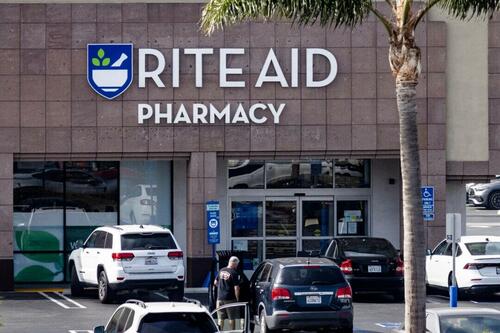
Банкротство Rite Aid снова пытается продать все активы
Автор Naveen Athrappully via Эпохальные времена,
Сеть аптек Rite Aid Corporation снова подала заявление о банкротстве менее чем через год после выхода из предыдущего. Теперь сеть хочет продать «по существу все свои активы». Об этом компания заявила 5 мая.

Rite Aid и ее дочерние компании подали заявление о банкротстве главы 11 в суд по делам о банкротстве в округе Нью-Джерси. Чтобы поддержать Rite Aid в процессе продаж, компания «обеспечила обязательства некоторых из своих существующих кредиторов по доступу к новому финансированию в размере 1,94 миллиарда долларов», говорится в заявлении.
«Ожидается, что это финансирование наряду с денежными средствами от операций обеспечит достаточное финансирование в ходе процесса продажи и судебного надзора. "
Активы, которые не продаются во время судебного процесса банкротства, будут изъяты или монетизированы.
Во время банкротства клиенты по-прежнему смогут получить доступ к аптечным услугам и продуктам в физических магазинах компании и в Интернете.
Сеть аптек "содействует беспрепятственной передаче рецептов клиентов другим аптекам. Обряд Сотрудники, оказывающие помощь в этом процессе, будут продолжать получать заработную плату и льготы, - говорится в сообщении компании.
Обряд Помощь ранее подала на банкротство в октябре 2023 года, поскольку она боролась с замедлением продаж и высоким долгом на фоне нескольких судебных процессов, обвиняющих компанию в опиоидном кризисе Америки.
В сентябре 2024 года обряд Компания объявила, что завершила процесс реструктуризации банкротства и будет работать как частная компания.
Компания заявила, что устранила примерно 2 миллиарда долларов из своего общего долга и получила около 2,5 миллиарда долларов финансирования.
Однако дела у компании пошли не гладко, о чем свидетельствует решение снова подать на банкротство.
Мэтт Шредер, генеральный директор Rite Aid, сказал, что компания «продолжает сталкиваться с финансовыми проблемами, усугубляемыми быстро развивающимися розничными и медицинскими ландшафтами, в которых мы работаем». "
Количество магазинов Rite Aid в США резко упало за последнее десятилетие. В 2012 году у компании было 4667 магазинов, что в 2023 году упало до 2309, по данным Statista. На веб-сайте Rite Aid указано, что в настоящее время количество магазинов составляет 1240.
Цепи наркотиков под стрессом
Сети аптек уже некоторое время борются. В октябре Walgreens объявила о планах закрыть 1200 своих магазинов в течение трех лет, а на 2025 финансовый год запланировано около 500 закрытий.
В марте компания сообщила, что будет передана частному инвестиционному предприятию Sycamore Partners за 10 миллиардов долларов. Генеральный директор Walgreens Тим Вентворт назвал проблемы «быстро развивающейся аптечной индустрии» и «все более сложной и конкурентоспособной розничной торговли». "
Нил Сондерс, управляющий директор по розничной торговле Global Data, сказал The Epoch Times, что цепочки лекарств сталкиваются с «коктейлем проблем». "
Он сказал, что аптеки росли слишком быстро и что теперь они имеют дело с более низкой прибылью от непатентованных лекарств. Некоторые из них стали неэффективными, в то время как другие пытались интегрировать решения в области здравоохранения в свой бизнес.
«Они пытались диверсифицировать сферу здравоохранения с разной степенью успеха и рационализировать бизнес, [они] сократили расходы, чтобы достичь прибыльности, что в конечном итоге привело к закрытию магазинов. Здесь нет простого решения, - сказал Сондерс.
Это то, через что им придется пройти в ближайшие пять лет, и это вызовет проблемы для потребителей. "
Эксперт по аптекам предполагает, что закрытие аптек заставит многих потребителей заполнять свои рецепты на лекарства по почте, особенно в сельских районах.
Это, по словам Сондерса, является более плохой новостью для обычных аптек.
«Не всем это нравится, но это дешевле для страховых компаний и, черт возьми, намного удобнее для потребителя. Это насущная потребность, и если ее можно доставить прямо в ваш дом, почему бы и нет?
«Как только люди переключатся и почувствуют себя комфортно, это в конечном итоге подорвет одну из точек дифференциации для аптек. Если потребители не пойдут в магазины, они не будут покупать импульсивные покупки, и их бизнес-модель рухнет. "
Согласно отчету от 23 января от консалтинговой компании по реструктуризации здравоохранения Gibbins Advisors, в прошлом году в Соединенных Штатах было 57 заявлений о банкротстве в области здравоохранения, что является вторым по величине числом заявок за последние шесть лет.
Он привел несколько факторов, включая ограничения капитала, нехватку рабочей силы, увеличение затрат и изменение нормативной среды.
Что касается 2025 года, Рональд Уинтерс, директор Gibbins Advisors, сказал: «в то время как новая администрация президента вносит некоторую неопределенность в систему здравоохранения, основные факторы, вызывающие проблемы со здоровьем, остаются неизменными. "
«Стандаловские и сельские провайдеры будут по-прежнему сталкиваться со значительными финансовыми проблемами, и сотрудничество с сообществами по эффективным решениям реструктуризации имеет жизненно важное значение для сохранения основных медицинских услуг в этих регионах», - сказал он.
Тайлер Дерден
Туэ, 05/06/2025 - 14:20














